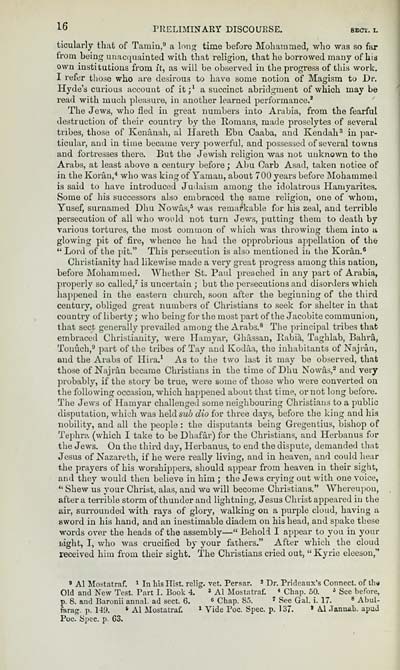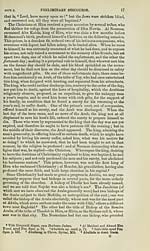Download files
Complete book:
Individual page:
Thumbnail gallery: Grid view | List view

16 rilELIMINARY DISCO UESE. sect, l
ticularly that of Tamiii,^ a long time before Mohammed, who was so far
from being unac(juainted with that religion, that he borrowed many of his
own institutions from it, as will be observed in the progress of this work.
I refer those who are desirous to have some notion of Magism to Dr.
Hyde's curious account of it;' a succinct abridgment of which may be
read with much pleasure, in another learned performance.*
The Jews, who iied in great numbei's into Arabia, from the fearful
destruction of their country by the Romans, made proselytes of several
tribes, those of Kenanah, al Hareth Ebn Caaba, and Kendah^ in ])ar-
ticular, and in time became very powerful, and possessed of several towns
and fortresses there. But the Jewish religion was not unknown to the
Arabs, at least above a century before ; Abu Oarb Asad, taken notice of
in the Koran,* who was king of Yainau, about 700 years before Mohammed
is said to have introduced Judaism among the idolatrous Hamyarites.
Some of his successors also embraced the same religion, one of whom,
Yusef, surnamed Dim Nowus,* was remarkable for his zeal, and terrible
persecution of all who woidd not turn Jews, putting them to death by
various tortures, the most common of which was throwing them into a
glowing pit of fire, whence he had the opprobrious appellation of the
" Lord of the pit." This persecution is also mentioned in the Koran."
Christianity had likewise made a very great progress among this nation,
before Mohammed. Whether St. Paid preached in any part of Arabia,
pi'operly so called,'' is uncertain ; but the persecutions and disorders which
happened in the eastern church, soon after the beginning of the tliird
century, obliged great numbers of Christians to seek for shelter in that
country of liberty ; who being for tlie most part of the Jacobite communion,
that sect generally prevailed among the Arabs.^ The principal tribes that
embraced Christianity, were Hamyar, Ghassan, Eabia, Taghlab, Bahra,
Toniich,^ part of the tribes of Tay and Kodaa, the inhabitants of Najran,
and the Arabs of Hira.' As to the two last it may be observed, that
those of Najran became Christians in the time of Dhu Nowas,^ and very
probably, if the story be true, were some of those who were converted on
the following occasion, which happened about that time, or not long before.
The Jews of Hamyar challenged some neighbouring Christians to a public
disputation, which was heldsub dio for three days, before the king and his
nobility, and all the people : the disputants being Gregentius, bishop of
Tephra (which I take to be Dhafar) for the Christians, and Herbanus for
tlie Jews. On the third day, Herbanus, to end the dispute, demanded that
Jesus of Nazareth, if he were really living, and in heaven, and could hear
the prayers of his worshippers, should appear from heaven in their sight,
and they would then believe in him ; the Jews crying out with one voice,
" Shew us your Christ, alas, and we will become Christians." Whereu])Ou,
after a terrible storm of thunder and lightning, Jesus Christ appeared in the
air, surrounded with rays of glory, walking on a purple cloud, having a
sword in his hand, and an inestimable diadem on his head, and spake these
words over the heads of the assembly — " Behold I appear to you in your
tjight, I, who was crucified by your fathers." After which the cloud
received him from their sight. The Christians cried out, " Kyrie eleeson,"
» Al Mostatraf. ^ In his Hist, relig. vet. Persar. » Dr. Prideaux's Connect, of tho
Old and New Test. Part I. Book 4. » Al Mostatraf. * Chap. 50. * See before,
p. 8. and Baronii annal. ad sect. 6. « Chap. 85. ^ See Gal. i. 17. " Abul-
farag. p. 149. » Al Mostatraf. ^ Vide Poc. Spec. p. 137. * Al Janoab. apud
Poc. Spec. p. 63.
ticularly that of Tamiii,^ a long time before Mohammed, who was so far
from being unac(juainted with that religion, that he borrowed many of his
own institutions from it, as will be observed in the progress of this work.
I refer those who are desirous to have some notion of Magism to Dr.
Hyde's curious account of it;' a succinct abridgment of which may be
read with much pleasure, in another learned performance.*
The Jews, who iied in great numbei's into Arabia, from the fearful
destruction of their country by the Romans, made proselytes of several
tribes, those of Kenanah, al Hareth Ebn Caaba, and Kendah^ in ])ar-
ticular, and in time became very powerful, and possessed of several towns
and fortresses there. But the Jewish religion was not unknown to the
Arabs, at least above a century before ; Abu Oarb Asad, taken notice of
in the Koran,* who was king of Yainau, about 700 years before Mohammed
is said to have introduced Judaism among the idolatrous Hamyarites.
Some of his successors also embraced the same religion, one of whom,
Yusef, surnamed Dim Nowus,* was remarkable for his zeal, and terrible
persecution of all who woidd not turn Jews, putting them to death by
various tortures, the most common of which was throwing them into a
glowing pit of fire, whence he had the opprobrious appellation of the
" Lord of the pit." This persecution is also mentioned in the Koran."
Christianity had likewise made a very great progress among this nation,
before Mohammed. Whether St. Paid preached in any part of Arabia,
pi'operly so called,'' is uncertain ; but the persecutions and disorders which
happened in the eastern church, soon after the beginning of the tliird
century, obliged great numbers of Christians to seek for shelter in that
country of liberty ; who being for tlie most part of the Jacobite communion,
that sect generally prevailed among the Arabs.^ The principal tribes that
embraced Christianity, were Hamyar, Ghassan, Eabia, Taghlab, Bahra,
Toniich,^ part of the tribes of Tay and Kodaa, the inhabitants of Najran,
and the Arabs of Hira.' As to the two last it may be observed, that
those of Najran became Christians in the time of Dhu Nowas,^ and very
probably, if the story be true, were some of those who were converted on
the following occasion, which happened about that time, or not long before.
The Jews of Hamyar challenged some neighbouring Christians to a public
disputation, which was heldsub dio for three days, before the king and his
nobility, and all the people : the disputants being Gregentius, bishop of
Tephra (which I take to be Dhafar) for the Christians, and Herbanus for
tlie Jews. On the third day, Herbanus, to end the dispute, demanded that
Jesus of Nazareth, if he were really living, and in heaven, and could hear
the prayers of his worshippers, should appear from heaven in their sight,
and they would then believe in him ; the Jews crying out with one voice,
" Shew us your Christ, alas, and we will become Christians." Whereu])Ou,
after a terrible storm of thunder and lightning, Jesus Christ appeared in the
air, surrounded with rays of glory, walking on a purple cloud, having a
sword in his hand, and an inestimable diadem on his head, and spake these
words over the heads of the assembly — " Behold I appear to you in your
tjight, I, who was crucified by your fathers." After which the cloud
received him from their sight. The Christians cried out, " Kyrie eleeson,"
» Al Mostatraf. ^ In his Hist, relig. vet. Persar. » Dr. Prideaux's Connect, of tho
Old and New Test. Part I. Book 4. » Al Mostatraf. * Chap. 50. * See before,
p. 8. and Baronii annal. ad sect. 6. « Chap. 85. ^ See Gal. i. 17. " Abul-
farag. p. 149. » Al Mostatraf. ^ Vide Poc. Spec. p. 137. * Al Janoab. apud
Poc. Spec. p. 63.
Set display mode to: Large image | Transcription
Images and transcriptions on this page, including medium image downloads, may be used under the Creative Commons Attribution 4.0 International Licence unless otherwise stated. ![]()
| Early Gaelic Book Collections > J. F. Campbell Collection > Koran: or, Alcoran of Mohammed > (38) |
|---|
| Permanent URL | https://digital.nls.uk/77134513 |
|---|
| Description | Volumes from a collection of 610 books rich in Highland folklore, Ossianic literature and other Celtic subjects. Many of the books annotated by John Francis Campbell of Islay, who assembled the collection. |
|---|
| Description | Selected items from five 'Special and Named Printed Collections'. Includes books in Gaelic and other Celtic languages, works about the Gaels, their languages, literature, culture and history. |
|---|

